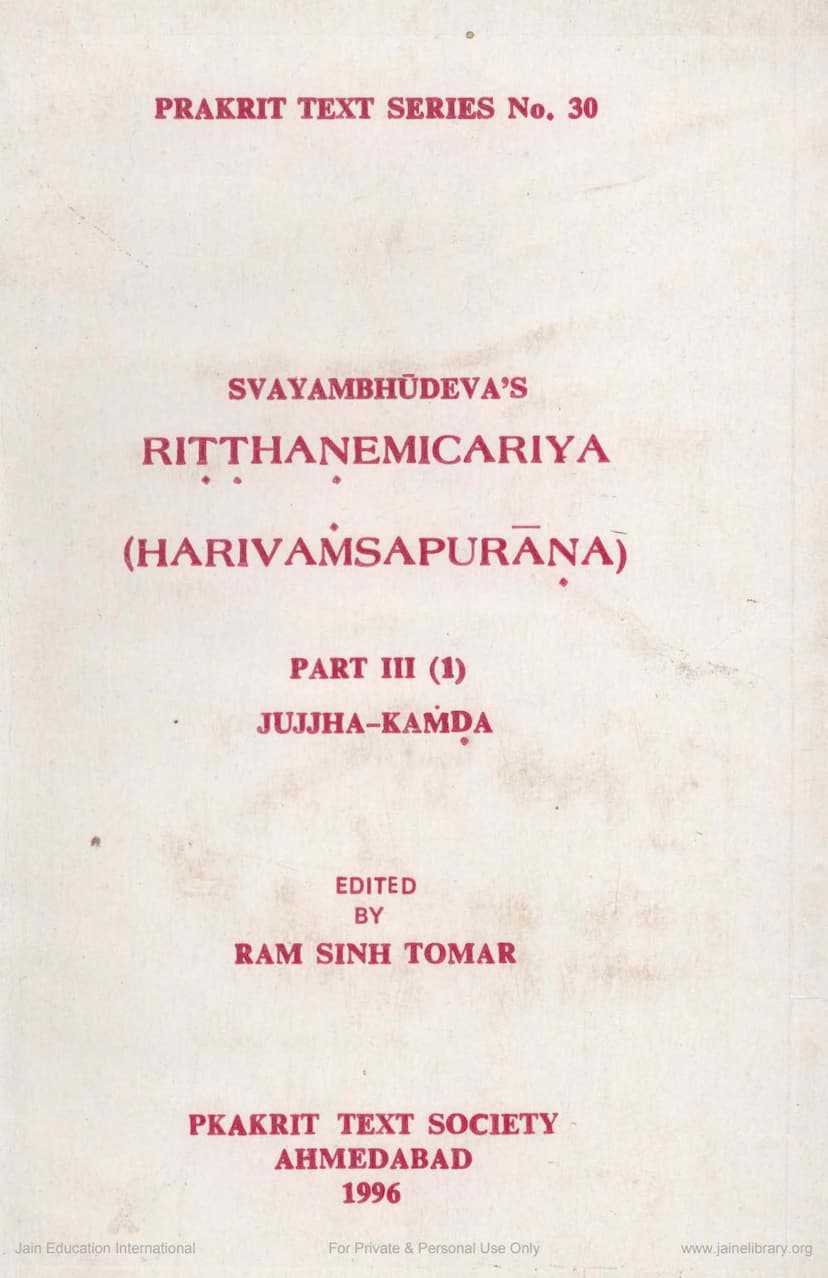Ritthnemichariyam Part 3 1
Added to library: September 2, 2025

Summary
Here's a comprehensive summary of the provided Jain text, "Ritthanemichariyam Part 3 (1) Jujjha-Kanda," based on the pages you've shared:
Book Title: Ritthanemichariyam (Harivamsapurana) by Swayambhudeva Part: III (1) Jujjha-Kanda (Book of Battle) Editors: Ramsinh Tomar, Dalsukh Malvania, H. C. Bhayani Publisher: Prakrit Text Society, Ahmedabad Year: 1996 Catalog Link: https://jainqq.org/explore/001428/1
Overall Context:
This document is a critical edition of Part III (1) of Swayambhudeva's "Ritthanemichariyam," also known as "Harivamsapurana." This particular volume focuses on the "Jujjha-Kanda" (Battle Section) of the epic poem. The "General Editors' Foreword" by Dalsukh Malvania and H. C. Bhayani indicates that this part (Sandhis 33-63) covers the initial thirty-one sandhis of the sixty sandhis that comprise the Jujjha-Kanda. They note that Swayambhu closely followed Vyasa's Mahabharata for the main narrative, incorporating Jain variations. He drew inspiration from the Mahabharata's accounts of battles, but condensed descriptions and dialogues to present an epitome of the incidents. The foreword also mentions an intention to discuss Swayambhu's use of the Mahabharata and the recension he likely consulted in a subsequent part.
Summary of Content (Based on the provided Sandhis):
The provided text contains Sandhis 33 through 66, detailing various events leading up to and during the great battle. The primary narrative thread revolves around the conflict between the Pandavas and the Kauravas, with Krishna (Kanhu/Keshav/Narayan) playing a central role.
Key Themes and Events Covered in the Sandhis:
- Discourse on Dharma and Morality (Sandhi 34): This sandhi appears to delve into the principles of dharma, righteousness, and the consequences of unrighteous actions, likely in the context of the impending war. The text discusses how dharma is the foundation for societal and individual well-being.
- The Kaurava's Stubbornness and Refusal to Make Peace: Several sandhis highlight Duryodhana's obstinate refusal to relinquish the kingdom to the Pandavas, despite numerous attempts at reconciliation, often mediated by Krishna. This stubbornness is portrayed as the root cause of the inevitable conflict.
- The Pandavas' Virtues and Krishna's Support: The narrative emphasizes the righteousness and virtues of the Pandavas, often contrasted with the Kauravas' vices. Krishna is consistently depicted as their supporter and protector.
- The Nature of the Human Body and Karma (Sandhi 34): A significant portion of Sandhi 34 seems to be a philosophical discourse on the human body, its transient nature, and the workings of karma. It describes the various components of the body and the cycle of birth and death, highlighting the importance of righteous actions.
- The Causes of War and Suffering: The text implicitly and explicitly points to greed, ego, and unrighteousness as the drivers of conflict and suffering. The dice game (Juyata) is often mentioned as a catalyst for much of the Pandavas' woes.
- The Battle of Kurukshetra (Jujjha-Kanda): The core of this volume describes the epic battles. Specific sandhis likely detail:
- The arrival and preparation of armies: The mustering of troops, the different formations, and the strategic movements of both sides.
- Individual duels and acts of valor: The text likely recounts the clashes between prominent warriors like Bhima, Arjuna, Karna, Duryodhana, Drona, Bhishma, etc.
- The divine intervention and support: Krishna's role in guiding and supporting the Pandavas.
- The carnage and destruction: The immense loss of life and the devastating impact of the war.
- The philosophical and moral lessons within the battle: Even amidst the violence, the text seems to weave in teachings on dharma, detachment, and the consequences of actions.
- The Role of Different Characters: The sandhis mention various key figures from the Mahabharata, including Krishna (Kanhu, Keshav, Narayan), Arjuna (Dhananjaya), Bhima, Yudhishthira (Dharmaputra), Duryodhana, Karna, Drona, Bhishma (Pitamah/Bhishma), Yudhisthira, Sahadeva, Nakula, and the Yadava clan.
- Swayambhu's Poetic Style: The sandhis are composed in Prakrit, characterized by their poetic meter (ghatta, helā) and vivid descriptions. The language aims to be evocative and engaging.
Overall Significance:
This part of the "Ritthanemichariyam" presents a Jain perspective on the Harivamsha narrative, focusing on the martial aspects and the moral dimensions of the great battle. It emphasizes the consequences of actions, the importance of righteousness, and the ultimate triumph of dharma, even amidst immense suffering. The work showcases Swayambhudeva's skill in adapting a well-known epic narrative to Jain philosophical and ethical principles.
Note: The summary is based on the visible content of the provided pages. A full interpretation would require a complete understanding of the Prakrit language and the broader context of the Jain tradition.